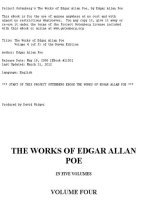Project Gutenberg''''s Familiar Letters of Chemistry, by Justus Liebig pptx
Bạn đang xem bản rút gọn của tài liệu. Xem và tải ngay bản đầy đủ của tài liệu tại đây (750.89 KB, 349 trang )
Project Gutenberg's Familiar Letters of
Chemistry, by Justus Liebig
This eBook is for the use of anyone
anywhere at no cost and with
almost no restrictions whatsoever. You may
copy it, give it away or
re-use it under the terms of the Project
Gutenberg License included
with this eBook or online at
www.gutenberg.net
Title: Familiar Letters of Chemistry
Author: Justus Liebig
Editor: John Gardner
Posting Date: August 8, 2009 [EBook #4524]
Release Date: October, 2003
First Posted: February 2, 2002
Language: English
*** START OF THIS PROJECT GUTENBERG EBOOK
FAMILIAR LETTERS OF CHEMISTRY ***
Produced by Steve Solomon. HTML version by
Al Haines.
FAMILIAR
LETTERS ON
CHEMISTRY,
AND ITS RELATION TO
COMMERCE,
PHYSIOLOGY, AND
AGRICULTURE,
BY JUSTUS LIEBIG,
M.D., PH. D., F.R.S.,
PROFESSOR OF CHEMISTRY IN
THE UNIVERSITY OF GIESSEN.
EDITED BY
JOHN GARDNER, M.D.,
MEMBER OF THE
CHEMICAL SOCIETY.
Second Edition, Corrected.
LONDON:
MDCCCXLIV.
PREFACE
The Letters contained in this little
Volume embrace some of the most
important points of the science of
Chemistry, in their application to Natural
Philosophy, Physiology, Agriculture, and
Commerce. Some of them treat of subjects
which have already been, or will hereafter
be, more fully discussed in my larger
works. They were intended to be mere
sketches, and were written for the
especial purpose of exciting the attention
of governments, and an enlightened public,
to the necessity of establishing Schools of
Chemistry, and of promoting, by every
means, the study of a science so intimately
connected with the arts, pursuits, and
social well-being of modern civilised
nations.
For my own part I do not scruple to
avow the conviction, that ere long, a
knowledge of the principal truths of
Chemistry will be expected in every
educated man, and that it will be as
necessary to the Statesman, the Political
Economist, and the Practical Agriculturist,
as it is already indispensable to the
Physician, and the Manufacturer.
In Germany, such of these Letters as
have been already published, have not
failed to produce some of the results
anticipated. New professorships have
been established in the Universities of
Goettingen and Wuertzburg, for the
express purpose of facilitating the
application of chemical truths to the
practical arts of life, and of following up
the new line of investigation and research
—the bearing of Chemistry upon
Physiology, Medicine, and Agriculture,—
which may be said to be only just begun.
My friend, Dr. Ernest Dieffenbach, one
of my first pupils, who is well acquainted
with all the branches of Chemistry,
Physics, Natural History, and Medicine,
suggested to me that a collection of these
Letters would be acceptable to the English
public, which has so favourably received
my former works.
I readily acquiesced in the publication of
an English edition, and undertook to write
a few additional Letters, which should
embrace some conclusions I have arrived
at, in my recent investigations, in
connection with the application of
chemical science to the physiology of
plants and agriculture.
My esteemed friend, Dr. Gardner, has
had the kindness to revise the manuscript
and the proof sheets for publication, for
which I cannot refrain expressing my best
thanks.
It only remains for me to add a hope, that
this little offering may serve to make new
friends to our beautiful and useful science,
and be a remembrancer to those old
friends who have, for many years past,
taken a lively interest in all my labours.
JUSTUS LIEBIG
Giessen, Aug. 1843.
CONTENTS
LETTER I
The Subject proposed. Materials
employed for Chemical Apparatus:—
GLASS—CAOUTCHOUC—CORK—
PLATINUM. THE BALANCE. The
"Elements" of the Ancients, represent
the forms of matter. Lavoisier and his
successors. Study of the materials
composing the Earth. Synthetic
production of Minerals—LAPIS
LAZULI. Organic Chemistry.
LETTER II
Changes of Form which every kind of
Matter undergoes. Conversion of Gases
into Liquids and Solids. Carbonic Acid
—its curious properties in a solid state.
Condensation of Gases by porous
bodies. By Spongy Platinum.
Importance of this property in Nature.
LETTER III
The Manufacture of Soda from
Culinary Salt; its importance in the Arts
and in Commerce. Glass—Soap—
Sulphuric Acid. Silver Refining.
Bleaching. TRADE IN SULPHUR.
LETTER IV
Connection of Theory with Practice.
Employment of MAGNETISM as a
moving power—its impracticability.
Relation of Coals and Zinc as
economic sources of Force.
Manufacture of Beet-root Sugar—its
impolicy. Gas for illumination.
LETTER V
ISOMERISM, or identity of
composition in bodies with different
chemical and physical properties.
CRYSTALLISATION. AMORPHISM.
ISOMORPHISM, or similarity of
properties in bodies totally different in
composition.
LETTER VI
ALLIANCE OF CHEMISTRY WITH
PHYSIOLOGY. Division of Food into
nourishment, and materials for
combustion. Effects of Atmospheric
Oxygen. Balance of CARBON and
OXYGEN.
LETTER VII
ANIMAL HEAT, its laws and influence
on the Animal Functions. Loss and
SUPPLY. Influence of Climate. Fuel of
Animal Heat. Agency of Oxygen in
Disease. Respiration.
LETTER VIII
ALIMENTS. Constituents of the Blood.
Fibrine, Albumen. Inorganic
Substances. Isomerism of Fibrine,
Albumen, and elements of nutrition.
Relation of animal and vegetable
organisms.
LETTER IX
Growth of Animals. Uses of Butter and
Milk. Metamorphoses of Tissues. Food
of Carnivora, and of the Horse.
LETTER X
Application of the preceding facts to
Man. Division of human Food. Uses of
Gelatine.
LETTER XI
CIRCULATION OF MATTER IN THE
ANIMAL AND VEGETABLE
KINGDOMS. The Ocean.
AGRICULTURE. RESTITUTION OF
AN EQUILIBRIUM IN THE SOIL.
Causes of the exhaustion of Land.
Virginia. England. Relief gained by
importation of bones. Empirical
farming unsatisfactory. Necessity for
scientific principles. Influence of the
atmosphere. Of Saline and Earthy
matters of the soil.
LETTER XII
SCIENCE AND ART OF
AGRICULTURE. NECESSITY OF
CHEMISTRY. Rationale of agricultural
processes. Washing for gold.
LETTER XIII
ILLUSTRATION OF THE NECESSITY
OF CHEMISTRY TO ADVANCE AND
PERFECT AGRICULTURE. Manner in
which FALLOW ameliorates the soil.
Uses of Lime. Effects of Burning. Of
Marl.
LETTER XIV
NATURE AND EFFECTS OF
MANURES. Animal bodies subject to
constant waste. Parts separating—
exuviae—waste vegetable matters—
together contain all the elements of the
soil and of food. Various value of
excrements of different animals as
manure.
LETTER XV
SOURCE OF THE CARBON AND
NITROGEN OF PLANTS. Produce of
Carbon in Forests and Meadows
supplied only with mineral aliments
prove it to be from the atmosphere.
Relations between Mineral
constituents, and Carbon and Nitrogen.
Effects of the Carbonic Acid and
Ammonia of Manures. Necessity of
inorganic constituents to the formation
of aliments, of blood, and therefore of
nutrition. NECESSITY OF INQUIRIES
by ANALYSIS to advance
AGRICULTURE.
LETTER XVI
RESULTS OF THE AUTHOR'S
LATEST INQUIRIES. Superlative
importance of the PHOSPHATES OF
LIME and ALKALIES to the cultivation
of the CEREALIA. Sources of a
SUPPLY of these MATERIALS.
LETTERS ON
CHEMISTRY
LETTER I
My dear Sir,
The influence which the science of
chemistry exercises upon human industry,
agriculture, and commerce; upon
physiology, medicine, and other sciences,
is now so interesting a topic of
conversation everywhere, that it may be
no unacceptable present to you if I trace in
a few familiar letters some of the relations
it bears to these various sciences, and
exhibit for you its actual effect upon the
present social condition of mankind.
In speaking of the present state of
chemistry, its rise and progress, I shall
need no apology if, as a preliminary step,
I call your attention to the implements
which the chemist employs—the means
which are indispensable to his labours
and to his success.
These consist, generally, of materials
furnished to us by nature, endowed with
many most remarkable properties fitting
them for our purposes; if one of them is a
production of art, yet its adaptation to the
use of mankind,—the qualities which
render it available to us,—must be
referred to the same source as those
derived immediately from nature.
Cork, Platinum, Glass, and Caoutchouc,
are the substances to which I allude, and
which minister so essentially to modern
chemical investigations. Without them,
indeed, we might have made some
progress, but it would have been slow; we
might have accomplished much, but it
would have been far less than has been
done with their aid. Some persons, by the
employment of expensive substances,
might have successfully pursued the
science; but incalculably fewer minds
would have been engaged in its
advancement. These materials have only
been duly appreciated and fully adopted
within a very recent period. In the time of
Lavoisier, the rich alone could make
chemical researches; the necessary
apparatus could only be procured at a
very great expense.
And first, of Glass: every one is familiar
with most of the properties of this curious
substance; its transparency, hardness,
destitution of colour, and stability under
ordinary circumstances: to these obvious
qualities we may add those which
especially adapt it to the use of the
chemist, namely, that it is unaffected by
most acids or other fluids contained
within it. At certain temperatures it
becomes more ductile and plastic than
wax, and may be made to assume in our
hands, before the flame of a common
lamp, the form of every vessel we need to
contain our materials, and of every
apparatus required to pursue our
experiments.
Then, how admirable and valuable are
the properties of Cork! How little do men
reflect upon the inestimable worth of so
common a substance! How few rightly
esteem the importance of it to the progress
of science, and the moral advancement of
mankind!—There is no production of
nature or art equally adapted to the
purposes to which the chemist applies it.
Cork consists of a soft, highly elastic
substance, as a basis, having diffused
throughout a matter with properties
resembling wax, tallow, and resin, yet
dissimilar to all of these, and termed
suberin. This renders it perfectly
impermeable to fluids, and, in a great
measure, even to gases. It is thus the fittest
material we possess for closing our
bottles, and retaining their contents. By its
means, and with the aid of Caoutchouc,









